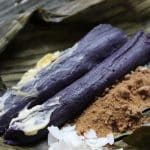Filipino Puto Bumbong - Steamed Purple Sticky Rice Logs with Coconut
Christmas is here. All the frenzy of the shopping, baking, running around non-stop is going to just go by in a whiff. But before it does, here’s a Filipino Puto Bumbong recipe that's the closest you can get to being home in the Philippines for the holidays. These are traditionally enjoyed along with slices of buttery bibingka (rice cakes). These violet sticky rice logs are a spectacular entrée for breakfast, brunch or snacks. They are typically steamed in the special steamer with bamboo tubes but if you can’t find this contraption steam them using a stove top steamer. And now, it’s time to relax and enjoy the joyous moments of the holiday season. This is an Asian in America recipe. Makes about 12 pieces.
Servings: 4 people
Calories: 551.79kcal
Equipment
- Puto Bumbong Steamer with Bamboo (from Asian markets or in the Philippines)
- Standard steamer
Ingredients
- 12 to 14 whole pieces banana leaves cut into 8 x 8 inches(freshly picked or frozen)
- 1/2 cup softened unsalted butter
- 2 cups rice flour
- 1 cup ube powder
- 1 cup brown sugar divided, use 1/2 cup for puto bumbong, half for topping
- 1 can (14 ounces) coconut milk
- 1/4 cup coconut cream
- 1/2 cup grated coconut meat (fresh or frozen) for topping (or use organic dessicated coconut flakes)
- for serving: piping-hot tea
Instructions
- Prepare the banana leaves: Wash with soap and water. Gently pat dry with paper towels. Cut them up in pieces of about 8 x 8 inches. Using a pair of scissors, cut off the tough yellow stringy parts on top or the spine of the leaf. Discard the tough yellow part. Set the leaves aside.
- To make the puto bumbong: In a large mixing bowl: Using a wooden spoon, combine the rice flour, ube (purple yam) powder, half a cup of brown sugar, coconut milk and cream. Blend ingredients well. The mixture will transform from a powdery to smooth, dough-like consistency and light lavender in color. Set aside.
- Place the banana leaves on the counter. Spread a teaspoon or two of softened butter in the center of each leaf. Place 2 heaping tablespoons of the violet rice flour mixture to the center of the leaf on top of the butter. Using a spoon or spatula, smoothen out the violet-colored rice flour mixture. Shape it like a long, thin log measuring about five to six inches.
- Wrap the violet logs individually like a thin burrito, tucking inside the edges. Start from your end, rolling the log away from you. Flatten them with the palm of your hand. Tie butcher’s string around the ends of each.
- Fill the bottom pan of a regular steamer with water about ¾ full. Cover and let the water come to a boil.
- If using the Puto Bumbong Steamer: Fill each of the holes below the bamboo tubes with water. Place the wrapped bumbong pieces inside the bamboo tubes, then put each inside the individual cylindrical steamers. Check the bamboo tubes, the smaller holes should be at the bottom. Place this contraption inside a large wok or saucepan with enough water for boiling. For this traditional steamer, steam the puto bumbong for 30 to 35 minutes.
- If using a regular steamer on the stove top: Place several pieces of the wrapped puto bumbong on the pan which has holes. Put this on top of the briskly boiling water. Then cover and steam for 25 minutes.
- To assemble: When puto bumbong is cooked, remove from the steamer and place on a dessert plate. Slather with some more butter. Sprinkle with grated coconut meat and brown sugar. Serve warm with hot tea.
- Additional Information: In the Tagalog language, it is spelled puto-bumbong. In Kapampangan it is spelled puto bungbong. In Batangueno, it is called puto sulot. (From the Philippine Food Cooking & Dining Dictionary by Edgie Polistico).
- Hello, Friends! All the images and content on this blog are COPYRIGHT PROTECTED and owned by my media company Besa-Quirino LLC. This means BY LAW you are NOT allowed to copy, scrape, lift, frame, plagiarize or use my photos and recipe content I wrote, on your website,books, films, television shows or videos without my permission. If you want to republish this recipe or content on another website, video, news article,or media outlets mentioned above please ASK my permission, re-write it in your own words and simply link back to this blog to give proper attribution. It’s the legal thing to do. Thank you. Email me at [email protected]
Nutrition
Serving: 1g | Calories: 551.79kcal | Carbohydrates: 119.06g | Protein: 5.38g | Fat: 6.39g | Saturated Fat: 4.97g | Sodium: 16.03mg | Potassium: 182.7mg | Fiber: 2.25g | Sugar: 53.45g | Vitamin C: 0.42mg | Calcium: 53.65mg | Iron: 1.01mg
